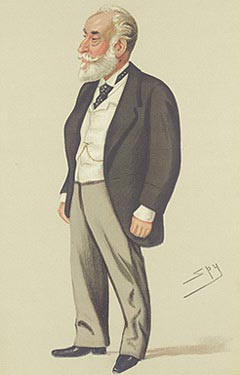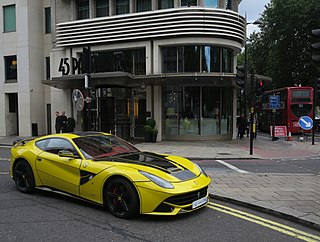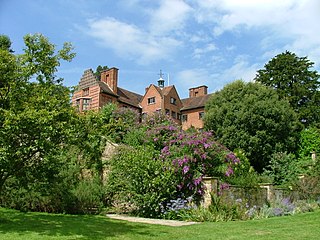
In the 19th century members of the English Rothschild family bought and built many country houses in the home counties, furnishing them with the art the family collected. The area of the Vale of Aylesbury, where many of the houses were situated, became known as "Rothchildshire". In the 20th century many of these properties were sold off with their art collections dispersed. Today only Eythrope House still belongs to the family; however, they still retain influence in how Ascott House and Waddesdon Manor are managed. In the loss of country houses in the 20th century only Aston Clinton was lost.

Sandgate is a northern coastal suburb in the City of Brisbane, Queensland, Australia. In the 2021 census, Sandgate had a population of 4,926 people.

Trent Park is an English country house in north London, accompanied by its former extensive grounds. The original great house, along with several statues and other structures within the grounds, such as the Orangery, are Grade II listed buildings. The site is designated as Metropolitan Green Belt, lies within a conservation area, and is also included at Grade II within the Register of Parks and Gardens of Special Historic Interest in England.

Sir Philip Albert Gustave David Sassoon, 3rd Baronet was a British politician and aristocrat. He served as a staff officer during the First World War, from July 1914 to November 1918.

Sir Albert Abdullah David Sassoon, 1st Baronet, was a Baghdad-born businessman and philanthropist.

Shorncliffe is a coastal north-eastern suburb in the City of Brisbane, Queensland, Australia. It is on the shore of Bramble Bay, part of Moreton Bay. The suburb attracts visitors to its historic Shorncliffe pier, and Lovers Walk, a walking path along the coastline between Shorncliffe and neighbouring Sandgate. In the 2021 census, Shorncliffe had a population of 1,907 people.

Sir Edward Albert Sassoon, 2nd Baronet was a British businessman and politician.

Sybil Rachel Betty Cecile Cholmondeley, Marchioness of Cholmondeley, styled Countess of Rocksavage from 1913 to 1923, was a British socialite, patron of the arts, and Chief Staff Officer in the Women's Royal Naval Service (WRNS) during the Second World War. She belonged to the prominent Sassoon and Rothschild families.

George Horatio Charles Cholmondeley, 5th Marquess of Cholmondeley, styled Earl of Rocksavage from birth until 1923, was a British peer. He was the Lord Great Chamberlain of England in 1936 and also between 1952 and 1966.

The Sassoon Mausoleum is the former grave of Sir Albert Sassoon and other members of his family, including Sir Edward Sassoon, 2nd Baronet, of Kensington Gore. It stands at 83 St. George's Road in Brighton, England. The single-storey building, which is Grade II listed, has since served as a furniture depository and an air-raid shelter, and since being purchased by a brewery in 1949 has remained a pub or bar.

Sandgate railway station was a railway station on the Sandgate Branch line serving the town of Sandgate in Kent. The station was positioned just after the railway crossed Hospital Hill and had two platforms and a brick built station building.

Alice Louisa Dudeney was an English author and short story writer. The wife of Henry Dudeney, a fellow author and inventor of mathematical puzzles and games, she used the style Mrs. Henry Dudeney for much of her literary career. She herself became a popular writer in her lifetime, who was often compared to Thomas Hardy for her portrayals of Sussex regional life. She had over fifty volumes of fiction published between 1898 and 1937.

Port Lympne, at Lympne, Kent is an early 20th-century country house built for Sir Philip Sassoon, 3rd Baronet by Herbert Baker and Philip Tilden. Completed after the First World War. Following Sassoon's death in 1939 it was bequeathed with its contents, including cars and planes, to Hannah Gubbay, his cousin. It was abandoned after the Second World War. In 1973, it was purchased by John Aspinall as part of an expansion of his Port Lympne Zoo. The house is a Grade II* listed building as of 29 December 1966.

25 Park Lane is a building on Park Lane, London.

Philip Tilden was an English architect, active in the early twentieth century, who worked for some of the most prominent members of English society, including Winston Churchill, David Lloyd George, Lord Beaverbrook, Sir Philip Sassoon, Lady Ottoline Morrell and Gordon Selfridge.
Arthur Abraham David Sassoon was an English banker and socialite.

David Sassoon & Co., Ltd. was a trading company operating in the 19th century and early 20th century predominantly in India, China and Japan.
Peter David Lyman Stansky is an American historian specializing in modern British history.

Drew Residence is a heritage-listed detached house at 20 Wharf Street, Shorncliffe, City of Brisbane, Queensland, Australia. It was designed by Samuel Drew and built from 1890s to 1940s by Samuel Drew. It is also known as Samuel Drew's House and the Captain's House. It was added to the Queensland Heritage Register on 24 November 2000.

The Liberal Jewish Cemetery, Willesden, is a cemetery for Jews in Pound Lane, Willesden, in the London Borough of Brent. It is adjacent to Willesden United Synagogue Cemetery. Established in 1911 by the Liberal Jewish Synagogue, it opened in 1914 and was originally known as the Liberal Jewish and Belsize Square Cemetery. Several notable British Jews, including members of the Sassoon family, are buried at the cemetery, which also has a Grade II listed war memorial.


















